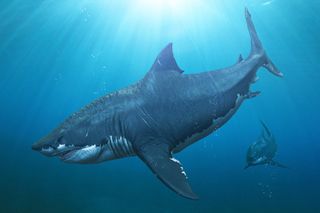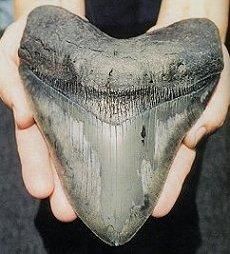Megalodon: Facts about the long-gone, giant shark
Megalodon was one seriously mega shark.

The megalodon, which went extinct millions of years ago, was the largest shark ever to prowl the oceans and one of the largest fish on record. The scientific name, Otodus megalodon, means "giant tooth," and for good reason: Its massive teeth are almost three times larger than the teeth of a modern great white shark. The megalodon shark's fossilized bones and teeth give scientists major clues about what the creature was like and when it died off.
When did megalodon go extinct?
While the popular 2018 movie, "The Meg," pits modern humans against an enormous megalodon sharks, it's actually more than likely that the beast died out before humans even evolved. But it's difficult to pinpoint the exact date that the megalodon went extinct because the fossil record is incomplete.
In 2014, a research group at the University of Zurich studied megalodon fossils using a technique called optimal linear estimation to determine their age. Their research, published in the journal PLOS ONE, found that most of the fossils date back to the middle Miocene epoch to the Pliocene epoch (15.9 million to 2.6 million years ago). All signs of the creature's existence ended 2.6 million years ago in the current fossil record, the authors wrote. For comparison, our earliest Homo sapiens ancestors emerged only 2.5 million years ago, during the Pleistocene epoch, according to the University of California Museum of Paleontology.
A very small portion of the Zurich study's data — 6 out of 10,000 simulations — showed a 1% chance that these giant sharks could still be alive. That chance seems pretty slim, and the researchers wrote in the study that they rejected "popular claims of present-day survival of O. megalodon."
Because no one has discovered any recent evidence of the monster — not even fossils that are any younger than 2.6 million years old — scientists agree that megalodon sharks are long gone.
How big was megalodon?
Megalodon shark size: The megalodon was a gigantic creature, but maybe not as big as you think. There are a lot of arguments in the scientific community about megalodon's size.
Going solely by the size of the teeth, some believe that the fish could grow up to 60 feet long (18 meters), according to the Natural History Museum (NHM) in London, while others think that about 80 feet (25 m) long is more likely, according to Encyclopedia Britannica.
For comparison, modern great white sharks (Carcharodon carcharias) reach lengths of 20 feet (6 m), according to Animal Diversity Web. Even larger is the whale shark (Rhincodon typus), which reaches 32 feet (9.7 m). The longest bony fish alive (sharks do not have bones; their skeletons are made of cartilage) is the giant oarfish (Regalecus glesne), which has been known to reach up to 36 feet (11 m), according to the Florida Museum of Natural History.
Related: Oarfish: Photos of World's Longest Bony Fish
"Original calculations greatly overestimated the size of megalodon," Marty Becker, a William Paterson University professor of environmental science who studies shark paleontology, told Live Science. "This is in part related to the fact that the megalodon fossil record is dominated almost exclusively by teeth. Current calculations indicate that megalodon may have achieved lengths up to 10 meters [around 33 feet] and nothing like what is currently featured in the summer 2018 movie 'The Meg.'"
Martin Becker is a professor in the Department of Environmental Sciences at William Paterson University in New Jersey. Becker’s research is based on self-collected fossil assemblages discovered across the United States and focuses primarily on evolutionary relationships of chondrichthyans, osteichthyans and reptiles. Becker has co-authored over 40 peer-reviewed manuscripts that document mass extinction, sea level history and large-scale climate change.
The largest megalodon tooth measures around 7 inches (17.8 centimeters) in length, which is almost three times longer than those of great white sharks. That giant size led ancient peoples to theorize about the creatures' origins. For example, early discoveries of megalodon shark teeth in western Europe were thought to be the petrified tongues of ancient serpents. People called them "tongue stones."
The impressive teeth are found all over the world in great quantities. "Teeth of megalodon are known to have a global occurrence and are prized among fossil collectors for their assorted colors, serrated edges and large size when compared to other fossil and modern shark teeth," Becker said. "Availability on the internet marketplace has devalued earlier fossil collections of megalodon teeth as investments."

Where did megalodon live?
Like the dinosaurs, the megalodon liked warmth. During its time, it hunted in the warm, shallow seas that covered much of the planet. Megalodon teeth have been found on every continent except Antarctica. Megalodon may have gone extinct when these seas dried up, the ice age began and water was locked up at the poles, according to Discovery. The shark either starved or was frozen into extinction.
What did megalodon eat?
The megalodon was a top-of-the-food-chain predator. It fed on other big marine mammals, like whales and dolphins. It may have even eaten other sharks, according to Discovery.
Researchers think the megalodon would first attack the flipper and tails of the mammals to prevent them from swimming away, then go in for the kill, according to the BBC. The megalodon's 276 serrated teeth were the perfect tool for ripping flesh.
These sharks also had a ferocious bite. While humans have been measured to have a bite force of around 1,317 newtons, researchers have estimated that the megalodon had a bite force between 108,514 and 182,201 newtons, according to the NHM.
"Megalodon co-evolved with whales as a principal food source," Becker said. "As mammals, whales had the ability to thermoregulate and migrate toward colder waters of the poles. While the exact thermoregulatory capabilities are a topic of current study, inability to hunt whales in colder water is believed to be one of the leading causes of megalodon extinction."
Fun facts about megalodon
—Cold waters may have killed the megalodon shark: Around 3.6 million years ago, as Earth entered a period of global cooling and drying, megalodons went extinct, according to the Natural History Museum. These sharks resided in tropical waters, but as sea temperatures dropped at the end of the Pliocene epoch, and seas began to freeze, megalodons' habitat may have been greatly restricted, Live Science reported. Meanwhile, much of their prey — primarily smaller whales, seals and sea turtles — died out or relocated to waters that were too cold for their shark predators.
—Megalodons had cannibal babies: To ensure survival, megalodon shark babies may have eaten their own siblings, Live Science previously reported. As each embryo would grow to take up significant space, eating them gave the surviving shark more room to grow and reach lengths of 6.6 feet (2 m) at birth.
—Megalodons existed for nearly 70 times longer than modern humans have: Megalodons inhabited the oceans for around 20 million years, according to the Natural History Museum, while Homo sapiens appeared around 300,000 years ago. The key to these sharks' long reign is likely their almost-invincible size. According to Smithsonian Magazine, the sharks could make a meal out of the majority of sea-life around at the time.
—Megalodon bites were the strongest of any animal: Megalodon bites are estimated to be at least six times as strong as those of Tyrannosaurus rex and more powerful than any known animal, Live Science previously reported. The estimated bite force of megalodons is between 108,514 and 182,201 Newtons (24,395 and 40,960 pound-force), according to the Natural History Museum. This enabled these monster sharks to munch down on large whales and fish. In comparison great white shark bites only manage 18,219 N (4,096 pounds), and humans a measly 1,317 N (296 pounds), the Natural History Museum stated.
—Their fossilized remains were mistaken for dragons' tongues: Before people made the connection between fossilized megalodon teeth and modern sharks' teeth, they thought these pointed rocks were the tips of dragons' tongues, according to Encyclopedia Britannica. In the 17th century, it was widely believed that these mysterious rocks had medicinal properties, and people would collect them for good luck, Smithsonian Magazine reported.
Additional resources:
- WSB-TV (Atlanta): Giant prehistoric Megalodon shark teeth found in hot spot along Carolina coast
- Discovery: Megalodon
- Deepsea News: How We Know Megalodon Doesn't Still Exist?
This article was updated on May 17, 2021 by Live Science Reference Editor Kimberly Hickok. Writer Ailsa Harvey contributed to this article.
Sign up for the Live Science daily newsletter now
Get the world’s most fascinating discoveries delivered straight to your inbox.

